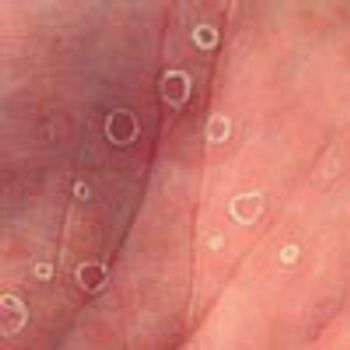
Identifying the cause of a persistent, asymptomatic aminotransferase elevation can be challenging. The possible diagnoses are many and varied. To narrow the differential, begin with a detailed history.

Identifying the cause of a persistent, asymptomatic aminotransferase elevation can be challenging. The possible diagnoses are many and varied. To narrow the differential, begin with a detailed history.

Fear of bioterrorism persists because of new reports of biological warfare, including the most recent attack that involved a Russian spy who was poisoned with polonium-210. However, vaccination against potential biological weapons, such as anthrax and smallpox, is controversial because of associated adverse effects.

Six months after testing positive for HIV in 10 bands, a 24-year-old homosexual man presented with a macular rash on his palms and soles. He first noticed the lesions 2 weeks earlier; they were not pruritic or painful. He also had a brighter, more inflamed rash in the groin and antecubital fossae that was presumed to be a yeast infection and was treated with fluconazole. He had no other symptoms.

NAPLES, Italy -- Long-term antiviral treatment may partly reverse liver cirrhosis in patients with chronic hepatitis C, researchers here said.

Within the past 7 years, the incidence of methicillin-resistant Staphylococcus aureus (MRSA) and Clostridium difficile infections has significantly increased. Risk factors for MRSA infection include previous antibiotic therapy and living arrangements such as prisons or military barracks that involve close, frequent contact with infected persons. Treat stable patients with MRSA skin infections with oral antibiotics in addition to incision and drainage; hospitalization and intravenous antibiotics are recommended for patients whose condition is unstable or who are unlikely to adhere to an oral regimen. A new strain of C difficile, BI/NAP1, has been associated with recurrent infection; more severe disease that mandates urgent colectomy; and dramatically higher mortality in vulnerable populations, such as older adults. Although oral metronidazole has been the mainstay of treatment of C difficile infection, oral vancomycin may be slightly more effective in patients with severe disease.

HOUSTON -- Human papillomavirus (HPV) infections are likely buoying up oropharyngeal cancer rates while other head and neck cancers decline, researchers said.

BALTIMORE -- When treating hepatitis B and HIV co-infection, physicians should use caution with the antiviral drug entecavir (Baraclude), researchers here said.

The incidence offluoroquinoloneresistantgonorrheacontinues torise in the UnitedStates, and the CDC isnow urging physicians toprescribe cephalosporinsfor patients with gonococcalinfections.

HOUSTON -- Patients with hepatitis C virus infection may have a 20% to 30% increased risk of developing non-Hodgkin's lymphoma, researchers here reported.

I read with interest the case of lymphogranuloma venereum (LGV) featured in Dr Henry Schneiderman's recent "What's Your Diagnosis?" column (CONSULTANT, February 2007, page 187). As one who has had a career-long interest in sexually transmitted disease, I feel compelled to make a few remarks regarding this case.

Yesterday, my laboratory reported to me that a pharyngeal swab tested positive for chlamydial infection (detected by DNA testing). This was not the first time I diagnosed sexually transmitted pharyngeal chlamydial infection in a patient. Readers beware: it does happen.

ATLANTA -- After a decade of decline, syphilis rates rose by 19% from 2000 through 2003, largely because of cases among men who have sex with men, according to a CDC study.

ATLANTA -- The rate of fluoroquinolone-resistant gonorrhea has become so high in the U.S. that physicians have been urged to switch to the last line of defense, the cephalosporins.

BOSTON -- Co-infection with HIV and either hepatitis B or C remains a clinical challenge, but new therapies appear to have increased the opportunities for effective treatment.

The Advisory Committee on Immunization Practices recommendsthe zoster vaccine for persons aged 60 years and older, whether ornot they have had a previous episode of herpes zoster.

It is sometimes difficult for women with genital warts to visualize their lesions. Offer patients a hand-held mirror so that they can see what the lesions look like, and recommend that they use a similar mirror at home to monitor the lesions' size and number.

This infection is caused by reactivationof varicella-zoster virus (VZV),which may remain latent in thedorsal root and cranial nerve gangliafor decades. Reactivation oftenoccurs for no apparent reason, althoughstress and immunosuppressionmay increase the risk.

This infection is caused by reactivationof varicella-zoster virus (VZV),which may remain latent in thedorsal root and cranial nerve gangliafor decades. Reactivation oftenoccurs for no apparent reason, althoughstress and immunosuppressionmay increase the risk.

LONDON -- Treating herpes simplex with valacylovir (Valtrex) reduces the levels of HIV in women who are infected with both viruses, according to researchers here.

SEATTLE -- For women, infection with a common sexually transmitted disease sharply increases the risk of contracting HIV, according to researchers here.

BOSTON -- A history of gonorrhea may translate into a twofold increased risk of bladder cancer for men, researchers here reported.

Liver disease, particularly hepatitis C, has emerged as a major cause of morbidity and mortality for people with HIV/AIDS in the era of potent antiretroviral therapy. Mortality is increased in patients with HIV–hepatitis C virus (HCV) coinfection compared with that in patients with HIV alone.1,2

Tinidazole (Tindamax), from PresuttiLaboratories, Inc., has been approvedfor treatment of trichomoniasis, giardiasis,intestinal amebiasis, and amebicliver abscess. A single 2-g doseis recommended for patients with trichomoniasisor giardiasis; in amebicdysentery, the recommended dosageis 2 g/d for 3 days. Patients with amebicabscess from amebic hepatitis require2 g/d for 3 to 5 days.

A 35-year-old woman has a lifelong history of recurrent blisters on the handsand feet that heal without scarring. No other family members have this condition,and she has no children. She is visiting your office for the first time toseek new treatment options.

In response to Dr Joseph Schube’s inquiry about a puzzlingurine culture that showed β-hemolytic streptococci (CONSULTANT,July 2002, page 974), I suggest that he consider oralintercourse as a possible source of the infection.